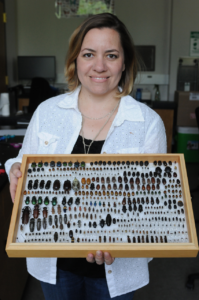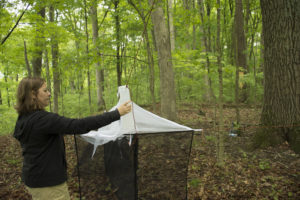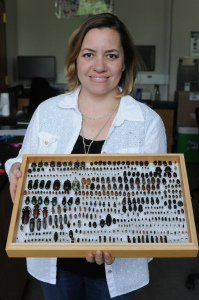By Glené Mynhardt, Ph.D.
My name is Glené Mynhardt. I am currently a biology professor at Hanover College. I obtained a Bachelor of Science degree in Biology from the University of Texas at Austin in 2004, completed a Master’s degree in Entomology at Texas A&M University in 2006, and earned a Ph.D. at The Ohio State University in 2012. Between 2004 and 2012, I focused all of my studies on understanding insect diversity, including the biology of economically important insects, like pecan weevil (Curculio caryae). Insects are distributed everywhere on our planet, and, despite there being more than one million described species known, their biology, and natural history are still poorly understood.
I support Senate Bill 420’s objective to set aside at least 10 percent of our state forests from logging to mature and turn over naturally as uneven-aged, old-growth forests and want to explain why.
I was hired by Hanover College as a Biology Professor in 2013. I have extensive knowledge of insect diversity, having worked in several states and on numerous biological survey projects. Since being hired at Hanover College, I have established one of the most comprehensive insect collections any small liberal arts college in the state of Indiana, which represents insects from our region, and recently, from Ecoblitz events sponsored by the Indiana Forest Alliance. Insect collections are one of the only ways scientists can document both a physical and permanent record of species diversity over time, which is why this work is so important to me.
 My work with the Indiana Forest Alliance began in the summer of 2014, when I expected to gain some insights into insect diversity at Morgan-Monroe and Yellowwood State Forests. After the first year of the Ecoblitz in 2014, and then again after 2015, I was hoping we would have a general understanding of the species richness (number of species) to be found in these forests. We limited our collecting only to sampling insects by hand (note that the beetle specialists used traps), both during the day and at night. No traps or other collecting methods were employed at this time, but it was clear, after we spent a few days both years at these locations, that we were barely sampling any of the existing insect diversity there.
My work with the Indiana Forest Alliance began in the summer of 2014, when I expected to gain some insights into insect diversity at Morgan-Monroe and Yellowwood State Forests. After the first year of the Ecoblitz in 2014, and then again after 2015, I was hoping we would have a general understanding of the species richness (number of species) to be found in these forests. We limited our collecting only to sampling insects by hand (note that the beetle specialists used traps), both during the day and at night. No traps or other collecting methods were employed at this time, but it was clear, after we spent a few days both years at these locations, that we were barely sampling any of the existing insect diversity there.
In the summer of 2016, we set up Malaise traps, designed to capture flying insects. Our goal was to better capture some of the diversity over not just a single weekend collecting event, but over the entire summer and into fall. When we brought samples back into my lab at Hanover, the sheer amount of insects was, and is, overwhelming. I had four students working with me in the lab to sort out specimens into what we propose are unique species. After 5-6 months of work in the lab, we still have very little idea of how many species we found, because of the challenge of identifying insects to species. What began as an effort to get a snapshot of the insect diversity in these areas has blossomed into a lifetime project! We have, very conservatively, collected many hundreds if not thousands of insects, all of which have to yet be identified by specialists. My expertise in beetles limits our abilities to do this quickly enough, which is why I am making the statement below.
In the time that we have been identifying the specimens collected, it has become very clear that we have very limited knowledge of how many species exist in our Indiana forests. Efforts of the IFA, with help of scientists from many different institutions, have led to one conclusion: without preserving large tracts of old-growth forests, we could lose hundreds of thousands of species that rely on these forest habitats for survival. The species we are identifying are forest specialists that have been part of Indiana’s forests for hundreds of thousands of years. The survival of these species depends on intact forests, with many relying on fallen trees of varying ages of decomposition and decay. We are collecting hundreds of species of wasps, beetles, and flies, all of which are interdependent on one another for all the different stages of insect life. Not only do our native forests house these species, but never before has any group of naturalists been able to fully sample the rich diversity before.
 We are facing what could be one of the most exciting ventures in understanding Indiana’s biological diversity, and we may lose it all. Across our planet, thousands of species go extinct each year, without scientists knowing anything about the biological importance of those species. We could be losing species that are important indicators of forest (and Earth’s) health, yet we don’t know much about these species in terms of their long-term reliance or impacts on these forests. Over the time that our planet has been in existence, it has taken millions of years for insects and other animals, including mammals, to evolve in the areas they not inhabit. We should be spending more time and energy to understand what we have in our own beautiful forests of Indiana before it is too late.
We are facing what could be one of the most exciting ventures in understanding Indiana’s biological diversity, and we may lose it all. Across our planet, thousands of species go extinct each year, without scientists knowing anything about the biological importance of those species. We could be losing species that are important indicators of forest (and Earth’s) health, yet we don’t know much about these species in terms of their long-term reliance or impacts on these forests. Over the time that our planet has been in existence, it has taken millions of years for insects and other animals, including mammals, to evolve in the areas they not inhabit. We should be spending more time and energy to understand what we have in our own beautiful forests of Indiana before it is too late.
In the lab, we have thousands of species that all rely on intact, deciduous forests for survival. And while we have many species, we still have limited knowledge of which impacts they have on our forests, which are slowly becoming small fragments of what they used to be. Habitat loss and fragmentation have largely resulted in the loss of biological diversity of insects. First we must understand which species are present in the first place (we do not yet have any close estimates). Second, without understanding which species are present in a given area or how much habitat space these species require, it is premature to make holistic decisions about preserve X amount of space for ALL species present in that area. As biologists, we do not yet fully understand how different species are impacted by habitat loss, or how vulnerable different species are to fragmentation. Even though our forests have been around for a long time, this is the first and possibly the last chance we get to study the impacts of local species in our forests, and on each other, over time.
The decisions we make today will have great impacts on what our children will be able to experience in the years to come. I, for one, would like generations after me to still experience the amazing diversity of life that lives in our forests. As a scientist whose mission it is to understand our living world, we need the time and support to understand what we have right here in Indiana. As humans, we can leave behind one legacy- we are the only species that has the intellectual capacity to understand the other organisms that share our planet, specifically our forests, with us. We rely on these species to maintain the forests we call home, the forests we like to frequent when we try to escape to get away from the busyness of life. Let’s try to first understand what we have before we lost it all.
The preceding testimony by Dr. Glené Mynhardt was given to the Indiana Senate Natural Resources Committee on Monday, February 13, 2017, during the hearing for Senate Bill 420.
Please contact your state senator and ask them to support Senate Bill 420.

